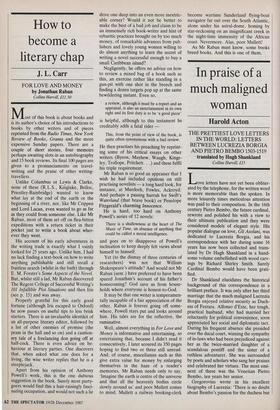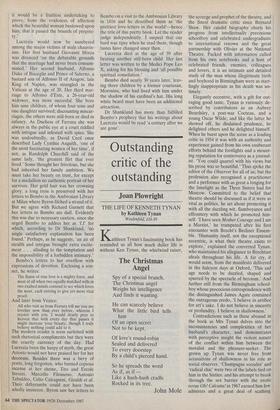In praise of a much maligned woman
Harold Acton
THE PRETTIEST LOVE LETTERS IN THE WORLD: LETTERS BETWEEN LUCREZIA BORGIA AND PIETRO BEMBO 1503-1519 translated by Hugh Shankland
Collins Harvill, £15
Love letters have not yet been obliter- ated by the telephone, for the written word is more memorable than the spoken. In more leisurely times meticulous attention was paid to their composition. In the 16th century Pietro Bembo, the future cardinal, rewrote and polished his with a view to their ultimate publication and they were considered models of elegant style. His popular dialogue on love, Gli Asolani, was dedicated to Lucrezia Borgia, and his correspondence with her during some 16 years has now been collected and trans- lated by Dr Hugh Shankland in a hand- some volume embellished with wood carv- ings by Richard Shirley Smith. Surely Cardinal Bembo would have been grati- fied.
Dr Shankland elucidates the historical background of this correspondence in a brilliant preface. It was only after her third marriage that the much maligned Lucrezia Borgia enjoyed relative security as Duch- ess of Ferrara. Alfonso d'Este, her tough, practical husband, who had married her reluctantly for political convenience, soon appreciated her social and diplomatic tact. During his frequent absence she presided over the ducal court, winning the sympathy of in-laws who had been prejudiced against her as the twice-married daughter of a scandalous pontiff and the sister of a ruthless adventurer. She was surrounded by poets and scholars who sang her praises and celebrated her virtues. The most emi- nent of these was the Venetian Pietro Bembo, ten years her senior.
Gregorovius wrote in his excellent biography of Lucrezia: 'There is no doubt about Bembo's passion for the duchess but it would be a fruitless undertaking to prove, from the evidences of affection which the beautiful woman bestowed upon him, that it passed the bounds of proprie- ty.'
Lucrezia would now be numbered among the major victims of male chauvin- ism. Her first husband Giovanni Sforza was divorced 'on the debatable grounds that the marriage had never been consum- mated.' Her second husband, Alfonso Duke of Bisceglie and Prince of Salerno, a bastard son of Alfonso II of Aragon, late King of Naples, was strangled in the Vatican at the age of 20. Her third mar- riage to Alfonso d'Este, a 26-year-old widower, was more succesful. She bore him nine children, of whom four sons and one daughter survived; discounting miscar- riages, the others were still-born or died in infancy. As Duchess of Ferrara she was always in the public eye at a court riddled with intrigue and infested with spies. She was undoubtedly, as David Cecil once described Lady Cynthia Asquith, 'one of the most fascinating women of her time', if not, as Randolph Churchill said of the same lady, 'the greatest flirt that ever lived.' Some thought her frivolous, but she had inherited her family ambition. We must take her beauty on trust, for except for a medallion no authentic portrait of her survives. Her gold hair was her crowning glory: a long tress is preserved with her letters to Bembo in the Ambrosian Library at Milan where Byron filched a strand of it.
But we agree with Richard Garnett that her letters to Bembo are dull. Evidently this was due to necessary caution, since she urged Bembo to addres her as 'f.f for which, according to Dr Shankland, `no single satisfactory explanation has been found.' Perhaps, as he suggests, 'an air of stealth and intrigue brought extra excite- ment . . . alluding to the temptation and the impossibility of a forbidden intimacy.'
Bembo's letters to her overflow with expressions of devotion. Enclosing a son- net, he writes:
The flame of true love is a mighty force, and most of all when two equally matched wills in two exalted minds contend to see which loves the most, each striving to give yet more vital proof.
And later from Venice: All who visit us from Ferrara tell me you are lovelier now than ever before, wherein I rejoice with you. I would dearly pray to heaven that with every day that passes it might increase your beauty, though I truly believe nothing could add to it. The modern reader is soon surfeited with such rhetorical compliments but they were the courtly currency of the day. Had Lucrezia been the harpy of myth, the great Ariosto would not have praised her for her decorum. Besides there was a bevy of poets, long forgotten, who burned copious incense at her shrine, Tito and Ercole Strozzi, Marcello Filosseno, Antonio Tebaldeo, Celio Calcagnini, Giraldi et al. Their dithyrambs could not have been wholly insincere. Byron saw her letters to Bembo on a visit to the Ambrosian Library in 1816 and he described them as 'the prettiest love-letters in the world'—hence the title of this pretty book. Let the reader judge independently. I suspect that our bard was tipsy when he read them, though tastes have changed since then.
Lucrezia died at the age of 39 after bearing another still-born child. Her last letter was written to the Medici Pope Leo X, asking for his blessing and 'all possible spiritual consolation.'
Bembo died nearly 30 years later, leav- ing three children by a former courtesan, Morosina, who had lived with him under the shadow of his cardinal's hat. His long white beard must have been an additional attraction.
Dr Shankland has more than fulfilled Bembo's prophecy that his writings about Lucrezia would be read 'a century after we are gone'.











































































































 Previous page
Previous page